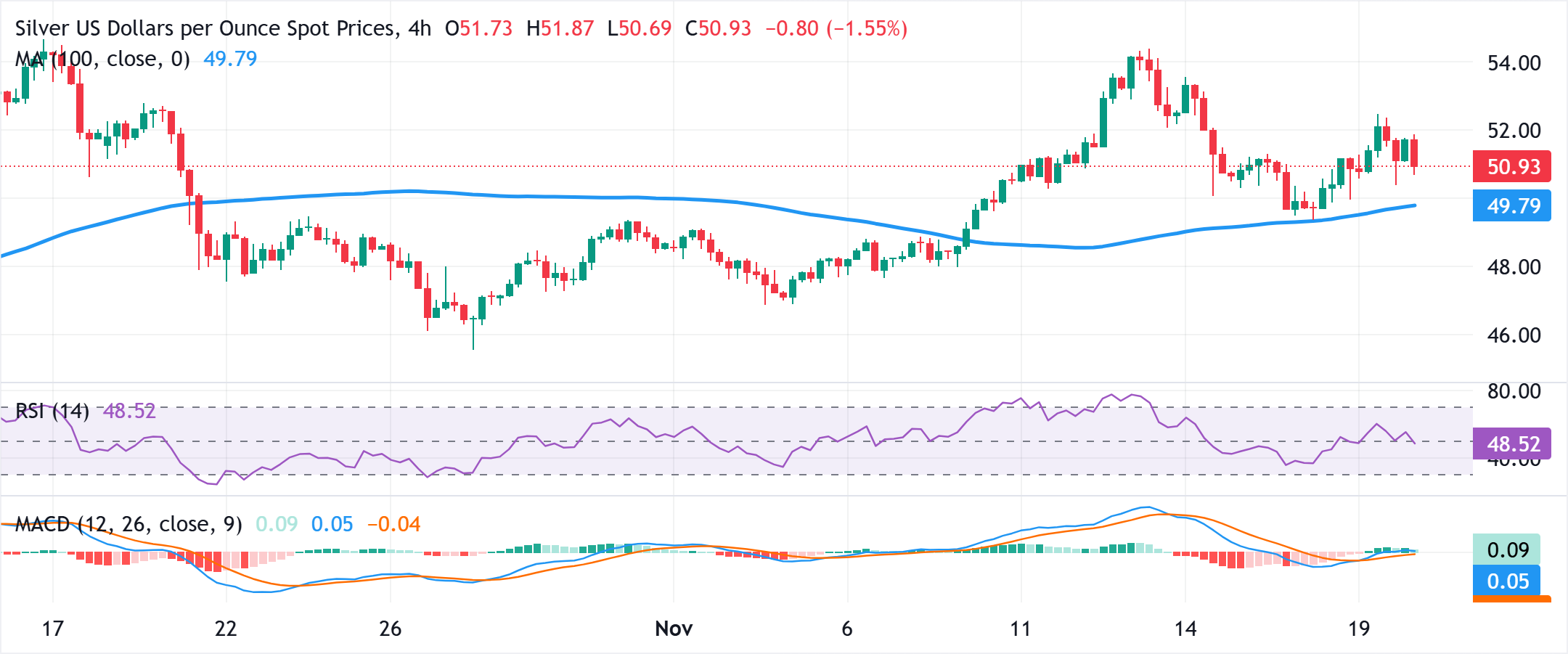Silver Price Forecast: XAG/USD could find support near 200-period SMA on H4, around $50.00
- Silver moves away from the weekly high set on Wednesday, though the downside seems limited.
- The technical setup backs the case for the emergence of dip-buyers near the 200-period SMA on H4.
- A convincing break and acceptance below the $50.00 mark would negate the positive outlook.
Silver (XAG/USD) attracts some sellers following an Asian session uptick to the $51.85 region and moves further away from the weekly high, touched the previous day. The white metal slides back below the $51.00 mark in the last hour, though the technical setup warrants some caution for bearish traders.
The XAG/USD found decent support and bounced off the 100-period Simple Moving Average (SMA) earlier this week. The said support is currently pegged near the $50.00 psychological mark and should act as a key pivotal point for short-term traders. A convincing break below would set the stage for the resumption of the retracement slide from a nearly four-week high, touched last Thursday.
The XAG/USD might then accelerate the downfall towards retesting the weekly swing low, around the $49.35 region touched on Tuesday. Some follow-through selling, leading to a subsequent break below the $49.00 mark, could make the commodity vulnerable and expose the next relevant support near mid-$48.00s. The downfall could extend further to the $48.00 round figure en route to the $47.15-$47.10 region.
On the flip side, the overnight swing high, around the $52.45 zone, now seems to act as an immediate hurdle, which, if cleared, will be seen as a fresh trigger for the XAG/USD bulls. The white metal might then aim towards reclaiming the $53.00 round figure before climbing further towards the $53.50-$53.55 region en route to the $54.00 mark and the monthly peak, around the $54.35-$54.40 region, touched last week.
Silver 4-hour chart

Silver FAQs
Silver is a precious metal highly traded among investors. It has been historically used as a store of value and a medium of exchange. Although less popular than Gold, traders may turn to Silver to diversify their investment portfolio, for its intrinsic value or as a potential hedge during high-inflation periods. Investors can buy physical Silver, in coins or in bars, or trade it through vehicles such as Exchange Traded Funds, which track its price on international markets.
Silver prices can move due to a wide range of factors. Geopolitical instability or fears of a deep recession can make Silver price escalate due to its safe-haven status, although to a lesser extent than Gold's. As a yieldless asset, Silver tends to rise with lower interest rates. Its moves also depend on how the US Dollar (USD) behaves as the asset is priced in dollars (XAG/USD). A strong Dollar tends to keep the price of Silver at bay, whereas a weaker Dollar is likely to propel prices up. Other factors such as investment demand, mining supply – Silver is much more abundant than Gold – and recycling rates can also affect prices.
Silver is widely used in industry, particularly in sectors such as electronics or solar energy, as it has one of the highest electric conductivity of all metals – more than Copper and Gold. A surge in demand can increase prices, while a decline tends to lower them. Dynamics in the US, Chinese and Indian economies can also contribute to price swings: for the US and particularly China, their big industrial sectors use Silver in various processes; in India, consumers’ demand for the precious metal for jewellery also plays a key role in setting prices.
Silver prices tend to follow Gold's moves. When Gold prices rise, Silver typically follows suit, as their status as safe-haven assets is similar. The Gold/Silver ratio, which shows the number of ounces of Silver needed to equal the value of one ounce of Gold, may help to determine the relative valuation between both metals. Some investors may consider a high ratio as an indicator that Silver is undervalued, or Gold is overvalued. On the contrary, a low ratio might suggest that Gold is undervalued relative to Silver.

